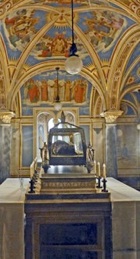

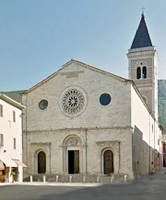
An inscription on the exterior of the left wall of the present church in Piazza dei Martiri della Libertà reads:
A.D.MCCLVI.TPE.G.ABBATIS. H.CENOBIU. E.TRASLATU. IN. GUALDO
("In 1256, during the time of Abbot William, this community was transferred to Gualdo”)
This records the fact that the Benedictines moved here in 1256 from the Abbazia di San Benedetto Vecchio outside the city.
San Benedetto Vecchio (1006, later demolished)
In 1006, Count Offredo di Nocera asked Abbot Placido of San Benedetto di Mugnano (Perugia) to assume the pastoral care of the dispersed people from Tadinum. He built the Abbazia di San Benedetto Vecchio on the banks of the River Feo [‘in vocabolo "Pomaiolo", di fronte alla chiesetta della Madonna delle Rotte’ - see the page Excursions from Gualdo Tadino]. Recent excavations at Pomaiolo have unearthed what could be the remains of the abbey.
Shortly thereafter, Tadinum lost its episcopal status, which passed to Nocera: local tradition places this event in 1007. The first bishop of the new diocese, which coincided with the holdings of the Counts of Nocera, was Adalberto, a monk of the Abbazia di San Benedetto "de plano Gualdi" (San Benedetto Vecchio).
[The Abbazia di San Benedetto Vecchio passed from the Benedictines to the Camaldolesians in 1188.]
When the first walled city of Gualdo on Monte Serrasanta was destroyed by fire in 1237, Epifanio, the abbot of San Benedetto, donated land on Colle Sant’ Angelo to the “sindacus” Pietro d’ Alessandro, for the construction of a new city. The Emperor Frederick II built its walls in 1242. As the inscription above records, the monks left this old abbey for the new one in 1256.
San Benedetto (1256)
As noted above, this church and abbey were established here soon after the completion of the walls of the new city. The monastery passed in commendam in 1441.
Pope Nicholas V commissioned Bernardo Rossellino to restore the complex in 1450. According to Giorgio Vasari, he “built the church of San Benedetto almost anew, … for he added to it good and beautiful buildings”.
Most of the relics of the Blessed Martius were translated from San Francesco to the Altare del Rosario of San Benedetto in 1907, while the tibia was translated to the Chiesa dell' Assunzione di Maria Vergine, Pieve di Compresseto (where it can be seen under the high altar).
In 1818, Pope Pius VIII abolished the secular commendam and placed San Benedetto under episcopal control. In 1847, Pope Pius IX removed this episcopal control and constituted San Benedetto as a collegiata administered by eight canons.
The diocese of Nocera became that of Nocera and Gualdo Tadino in 1915, at which the Collegiata of San Benedetto was raised to the status of a co-cathedral. In 1986, this diocese was merged with that of Assisi.
The church has been completely restored since the earthquake of 1997.
Excavations in Piazza Garibaldi (behind San Benedetto) in 2009 (during roadworks) uncovered what are probably remains (13th century) of the adjoining abbey.
Exterior
The façade of the church, which retains the three original portals and the central rose window, was completed in the 14th century.
The upper part of the façade and the campanile were destroyed in the earthquake of 1751. The present structure was built in 1875.
Fountain (1573)
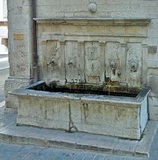
Michelangelo Lucesole da San Pellegrino di Gualdo built the fountain on the right wall of the Duomo to a design attributed to Antonio di Sangallo the Elder. It contains the arms of the papal legate, Cardinal Antonio Ciocchi del Monte (1513-33), who rebuilt the ancient aqueduct that feeds it.
Interior
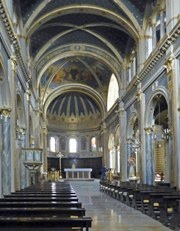
Virginio Vespignani re-modelled the interior in 1875.
It comprises a nave that culminates in an octagonal apse, and two aisles.
The high altar (late 14th century), which has a relief of the meeting of St Benedict and Totila, was rebuilt in 1965.
[Renaissance font; Silver and enamel Cross (1381) – in San Francesco ??; Gilded wooden tabernacle (16th century); Wooden crucifix (15th century)]
Tobias and the Angel (1586)
This altarpiece by Giovanni Maria Baldassini of Gubbio is [where ?]
Frescoes (1923-24)
These frescoes on the walls and vaults by Ulisse Ribustini depict the life of the Blessed Angelus (below).
Copy of Raphael’s Foligno Madonna (17th century)
This copy of Raphael’s famous altarpiece is by/attributed to Avanzino Nucci.
Altarpieces (17th century)
The following altarpieces have recently been attributed to Avanzino Nucci:
-
✴St Charles Borromeo venerating the Madonna and Child; and
-
✴Pentecost.
Crypt
Art from the Church
Polyptych (1462-5)
This reconstituted polyptych in the Brera Museum, Milan is now accepted to contain panels from two different polyptychs:
-
✴the upper set of panels, which depict the Crucifixion and SS Sebastian, Peter, Laurence and Jerome, came from San Benedetto:
-
✴the upper set of panels, which depict the Madonna and Child with angels and SS Augustine, Catherine of Alexandria, Apollonia and Nicholas of Tolentino, came from an unidentified Augustinian church.
The five panels from San Benedetto were sold in 1914 to the Poldi Pezzoli Museum, which already owned the other panels. They were previously attributed to Girolamo di Giovanni da Camerino but have more recently been given to Giovanni Angelo d’ Antonio da Camerino.
The fate of the other panels from each of the polyptychs is unknown.
Assumption of the Virgin with saints (15th century)
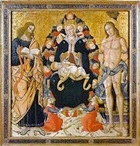
Madonna and Child in glory (16th century)
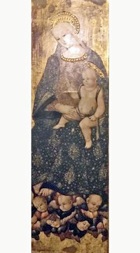
Madonna del Rosario (1620)
The inscription of this now-lost altarpiece from San Benedetto recorded that it had been painted in Rome in 1620 by Avanzino Nucci and described him as “gualdensis” (from Gualdo).
Return to Monuments of Gubbio.
Return to: Walk around Gualdo Tadino (San Benedetto); or
Excursions from Gualdo Tadino (San BenedettoVecchio).
